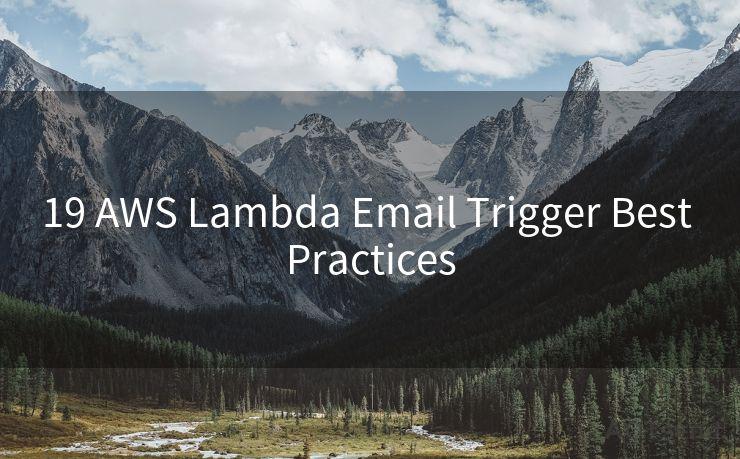19 AWS Lambda Email Trigger Best Practices




1. Introduction
In the cloud computing era, AWS Lambda has become a popular choice for running code without provisioning or managing servers. When it comes to triggering Lambda functions based on email events, there are several best practices to follow. In this article, we'll explore 19 essential best practices for using AWS Lambda with email triggers.
2. Set Up an Effective Email Parsing System
To effectively trigger Lambda functions based on emails, you need a robust email parsing system. Use services like Amazon SES (Simple Email Service) to receive and parse incoming emails. Ensure that your parsing logic can accurately extract relevant data from the email body and subject.
3. Validate Email Authenticity
Before triggering any Lambda function, it's crucial to validate the authenticity of the incoming email. Implement DKIM, SPF, and DMARC to reduce the risk of spam or phishing emails falsely triggering your functions.
4. Optimize Lambda Function Code
Keep your Lambda function code lean and efficient. Avoid unnecessary dependencies and optimize for fast execution times. This ensures quicker responses and reduces costs.
5. Use Environment Variables for Configuration
Instead of hardcoding configuration details like email addresses or API keys, use Lambda's environment variables. This makes your code more flexible and secure.
🔔🔔🔔
【AOTsend Email API】:AOTsend is a Managed Email Service for sending transactional emails. Support Email Types: reminders, authentication, confirmations, notifications, verification codes, invoices, password resets, account activations, billing statements, two-factor authentication (2FA), and one-time passwords (OTP) emails, etc. $0.28 per 1000 Emails. 99% Delivery, 98% Inbox Rate.
You might be interested in:
Why did we start the AOTsend project, Brand Story?
What is a Managed Email API, How it Works?
Best 25+ Email Marketing Platforms (Authority,Keywords&Traffic Comparison)
Best 24+ Email Marketing Service (Price, Pros&Cons Comparison)
Email APIs vs SMTP: How they Works, Any Difference?
6. Handle Errors Gracefully
Implement robust error handling in your Lambda functions. Use try-catch blocks, and log errors for later analysis. This helps in debugging and improving your functions.
7. Monitor and Alert on Failures
Set up monitoring and alerting using AWS CloudWatch. This way, you'll be notified immediately if there are any failures in your Lambda functions.
8. Control Concurrency
Manage concurrency settings for your Lambda functions to prevent resource exhaustion. AWS allows you to set concurrency limits to avoid unexpected costs or performance issues.
9. Leverage AWS X-Ray for Tracing
Enable AWS X-Ray tracing for your Lambda functions. This helps you understand the performance bottlenecks and improve your code's efficiency.
10. Secure Your Lambda Functions
Ensure that your Lambda functions are securely configured. Use IAM roles and policies to restrict access and prevent unauthorized invocations.
11. Test in a Staging Environment
Before deploying to production, test your Lambda functions in a staging environment. This helps identify and fix any issues before they affect live systems.
12. Use Dead Letter Queues (DLQs)
Configure DLQs to handle failed Lambda invocations. This ensures that failed messages are not lost and can be processed later.
13. Optimize for Cost
Monitor your Lambda functions' usage and adjust memory and timeout settings to optimize costs. Higher memory settings can improve performance but also increase costs.
14. Document Your Functions
Maintain clear documentation for your Lambda functions. Include input/output formats, dependencies, and any special considerations.
15. Implement Version Control
Use version control (e.g., Git) for your Lambda function code. This allows you to track changes, revert to previous versions if needed, and collaborate with others.
16. Automate Deployments
Automate the deployment of your Lambda functions using CI/CD pipelines. This ensures faster and more reliable updates.

17. Backup and Disaster Recovery
Regularly backup your Lambda functions and associated resources. Have a disaster recovery plan in place to quickly restore services in case of any unexpected events.
18. Stay Up to Date with AWS Updates
Keep yourself updated with the latest AWS Lambda features and best practices. AWS continuously improves its services, and staying informed can help you optimize your functions further.
19. Continuously Monitor Performance
Continuously monitor your Lambda functions' performance using CloudWatch metrics and logs. This helps you identify and address any performance issues promptly.
By following these best practices, you can ensure that your AWS Lambda email trigger setup is efficient, secure, and cost-effective. Remember to regularly review and update your implementation as AWS Lambda and its ecosystem continue to evolve.




Scan the QR code to access on your mobile device.
Copyright notice: This article is published by AotSend. Reproduction requires attribution.
Article Link:https://www.mailwot.com/p6464.html



